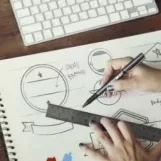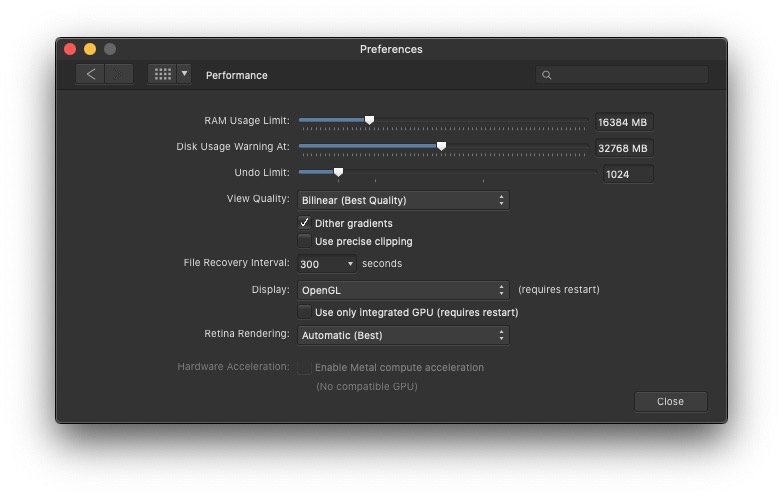Search the Community
Showing results for tags 'redraw'.
-
Two issues: 1) As you can see while doing a step and repeat of the square, the horizontals are not redrawn in Outline view. 2) Also noticed that diagonal lines are breaking up while using the Hairline View mode, under Advanced View Mode... Screen Recording 2023-10-23 at 11.30.26 AM.mov Screen Recording 2023-10-23 at 11.33.24 AM.mov
-
in this example I'm using Designer 2.1.1. I have many layers on the background, I used shortcut ctrl+H to "hide others". Then, I used ctrl+shift+H to show everything again, nothing happens. panning the view, still nothing. zooming in or out fixes the problem. In windows I was using picture in picture addon for a video, using MS Edge.
-
Hello , Found this issue while zooming into edit small vector. Interface fast while not zoomed in, but when you get close the interface goes blurry and takes along time to redraw. Tried this on version 1 as well, no issue in V1. Video attached. Gary Designer_2023-01-25_11-14-52.mp4
- 9 replies
-
- windows 10
- msi installer
-
(and 3 more)
Tagged with:
-
I have tried this in Designer 2 on both Windows 11 and macOS Ventura with either minimal performance settings and acceleration enabled. It doesn't seem to be related to drivers or accelleration. In both very simple documents with 10 simple layers and in rather complex documents this results in the exact same behavior: Select topmost layer Select hide others (works as expected) Select show others immediately Selected layer is still visible Others are still invisible Resize the entire application window or zoom in/out Incorrectly invisible layers are now redrawn but slowly in chunks And the pattern is: Select layer number two Select hide others (works as expected, two layers are displayed others are hidden) Select show others immediately Topmost layer and second layer is visible Others are still invisible Resize the entire application window or zoom in/out Incorrectly invisible layers are now redrawn but slowly in chunks etc. etc.
- 11 replies
-
- redraw
- show others
-
(and 1 more)
Tagged with:
-
To Serif team. May we please know, in the end of 2021, why canvas rendering algorithms are still so terrible in all Affinity apps? It's just not pleasant to see at all. Lots of glitches, fps drops, screen tearing, jumping objects and visible tiling/blocky artefacts during any changes being made. While searching here on forums, I found lots of topics covering all these issues. Some of them are five or six years old. But some of these topics are much more recent. Various configurations, pretty good CPUs and GPUs of all sorts. But same screen tearing, artefacts and visible tiles. For a such long period of time. And there are still no fixes for that. In some of those topics I've found official responses, that "this is done by design", "it's the way our apps render the canvas". Well, it's not a good design then. And certainly not a good way to render the canvas. How you, at Serif, find it acceptable? Are you ok with seeing canvas rendering like that in your apps? How it passes QA and being shipped to your customers? Why there are headlines on Affinity website: "fast and glorious", "pan and zoom at 60fps", "handle 1000s of objects with no lag", "optimized for documents of any complexity"? When it is simply not true, but rather false statements. At least it is not true as long, as such core performance problems still persist for so many people, including myself. Why not consider implementing something like v-sync in your canvas rendering pipeline? Or something else that will prevent visible artefacts appearing during canvas updates. So it will wait for all the tiles to finish calculating their image data and then the whole visible part of the canvas will be composited and painted in a single (at least on the visible to user level) draw event. It will significantly reduce overall performance? Well, maybe, but then you'll need to find a solution for this as well. Now it looks like the best idea for you was to throw all these tiles at your customer's screen as fast as possible. Because who notice that mess? They'll be fine with that. But I do notice that. And I want to avoid any screen tearing and tile artefacts in my experience with apps even on the most basic and simple tasks. So, where is mine "smooth and glorious 60fps experience"? I'm not even starting doing any serious graphic design work because I don't like your canvas in its current state. Sorry. Second, why mouse polling rate plays such significant role in your apps canvas performance? Recently I discovered this myself, and it was confirmed with your team members, that reducing mouse polling rate to default 125Hz significantly improves screen canvas performance. Significantly, but still not perfect yet. So why not restrict any user input events and sync them with dispay refresh rate / gpu redraw cycle? Just an example. The latest Safari has new option in their Debug menu: "Prefer Page Rendering Updates near 60fps". It ignores the display's refresh rate and throttle all in-window paint events down to commonly safe and achievable 60fps. So why not consider something like this and limit overall fps and user input event processing for the sake of overall performance improvement? Maybe then we'll get a better canvas? My main question is: is it an absolutely impossible to seamlessly refresh the canvas without all these tiles flickering around constantly once anything is changed in the viewport? I'm just wondering why it is still being considered as normal in Affinity apps to have a canvas behaving this way? Sorry if my post seems to be a rant or offended you in some way. I had no intent of doing that. I'm really wondering if Affinity suite can be made better for all of us. Or we shouldn't expect anything better being done in this direction. Maybe it's really a one big "pain in the a.s" problem for any software developers to make CPU and GPU properly talk to each other? Maybe there are lots of problems with major OS developers ditching OpenGL and moving towards Metal/DirectX? Also, we've seen this recent Apple's movement from separate CPU and GPU with dedicated memory to SoC solutions with unified, shared memory. Yes, I can understand that your apps should greatly benefit from that. Obviously, lower latencies, less memory copy operations, overall faster access to data. All things being done in one place. But... But at the same time I feel that it's just wrong to keep telling anyone on Twitter how good and fast your apps perform on those recent Apple SoCs, while its canvas (which is the main working and the most important area) lags and glitches in general for anyone with more traditional system configuration, even on the most simple scenarios like moving an artboard or a single layer around. I couldn't be the one who notices that. And my system is pretty powerful and it's clear that it deserves better performance and smoother visual response. What I see now is simply unacceptable for me. To be completely honest, I must say that I love your apps. Overall, they are much, much better for me than anything I've seen in this field. There are so many great features and innovative decisions, little details, that make it truly great. Every time I discovered these in your apps I was so excited and happy, because I remembered how bad the same thing was in Adobe's products. I remember lots of annoying, terrible things that made me leave Adobe's universe once and forever. Vast majority of these things remain unchanged for many years. Because they don't care about their software and customers at all. I found your company and your products to be a complete opposite. Small and passionated company with people really interested in their products. I don't want to be disappointed with you guys. I believe in you. I believe in Serif. Just can't stand this canvas tiles flickering and tearing. Sorry.
- 10 replies
-
- performance
- canvas
- (and 8 more)
-
I see this problem on a regular but intermittent basis. When I have two (or more) documents open in Publisher or Designer and I switch between documents, the screen does not redraw correctly and leaves large areas in black. To 'fix' this, I have to scroll up or down within the document to force a screen redraw or close and reopen it. I cannot take a screen recording as I cannot deliberately replicate this as it happens randomly so I have taken a screenshot from Designer. I am using a late 2013 27" iMac with 16Gb of RAM and a 2TB SSD installed. It also happens on my 2015 MacBook Pro 15" with 16GB RAM and 256GB SSD. As this does not happen in any applications other than Publisher and Designer, it leads me to believe it is an Affinity problem especially as it happens on two separate Macs. Both applications are 1.9.2 but this has also been happening in previous versions. I have also a screenshot of the Performance tab in Designer Preferences so you can see how it is set up. Publisher's preference pane is set the same.
- 4 replies
-
- screen
- screenshot
- (and 6 more)
-
Designer 1.8.5.703 on Windows 10 Home. If you watch the video you can see that: 1. Moving the Transform Origin seems to be fine except when the layer is also moved (maybe because snapping is ‘revoked’?); 2. There are redraw issues when the user presses and releases the right mouse button while moving the Transform Origin. Note: I looked for other reports but couldn’t find any that mentioned these issues. Apologies if this is a duplicate. 2020-08-30 12-49-26.mp4
-
I've noticed after recent updates that there is a change in behaviour when zooming in and out on Affinity Designer documents. The items on screen seem to pixelate slightly as I zoom, then sharpen back up once the view is fixed. I swear it never used to do this. Is this a performance option or related to the graphics card perhaps? A video reviewer on YouTube also pointed this out when taking a first look at AD.
- 3 replies
-
- pixelation
- zoom
-
(and 1 more)
Tagged with:
-
As already experienced in AP and AD the Publisher sometimes has a serious issue with a permanent redraw of the screen when just MOVING the mouse (not clicking anywhere). It does not appear, when the mouse is untouched. This needless flickering drives you crazy. Sometimes it is gone when you activate other applications. For example each time I activate a screen capture program to record the effect it is gone. It occurs with an ordinary mouse as well as with my wacom tablet. Cheers,. Timo
- 3 replies
-
- screen
- flickering
-
(and 2 more)
Tagged with:
-
I thought the problem was gone but it still seems to be there. If I just move the cursor over a picture without even pressing a mousebutton the window (including content and window scales at the side) randomly but frequently does a complete redraw. This is independent how far the movements are. It can happen between 5 times a second to every 5 seconds - unpredictably. This of course results in constant flickering of the window when you work with it. First I thought it was related to my wacom tablet but it happens with the mouse as well. I tried to record it with a screen capture program but all the time screen capture is running it does not happen at all. The redraw does not affect the AP program elements e.g. toolbar or even floating panels over the window itself. Cheers, Timo
-
This bug was present in a beta a long time ago and seems to have returned. There are strange screen redraw tiling artifacts. Check out the highlighted areas, these are the most prominent but it's actually happening across the entire image.
-
I am glad to see importing excel contents in a table now works, which was a big issue for me. I still need to get used to the way tables work in Publisher, but I will get the hang of it. I do run into some redraw issues when dragging the cells of the table sometimes, making it smaller. So some things appear twice on the screen, when only one is there (I don't know if ghosting is the right term?) These mostly disappear when I scroll or zoom, but are a bit annoying. Hope you can squash this bug? table_issue.mov
-
When zooming in on a layered file made in AP but opened (not placed) in AD past about 500% zoom, a strange grid starts to appear as the screen redraws.... Enclosed are some images for your reference. I can also email the AP file if need be, just quote me in your response so I get notified... Here are the screen grabs, notice the zoom level change and the grid of non-rectangular pixels that appears...
-
I am experiencing a problem with Affinity Photo sufficiently severe as to make it unusable and sufficiently odd as to make it very hard to describe. So to save you all asking questions that I may have addressed already I shall take you through steps to date. This will be longish. The problem manifests itself as a severe re-draw delay. In its mild form it can cause jerky intermittent re-draws as the cursor moves. In it’s severe form NO redraw occurs at all until the pen is lifted from the slate. In both cases the cursor is continuously redrawn and moves smoothly but the operation being performed is not being properly re-drawn. The severity changes from tool to tool. It is very severe with selection tools, transforms, crop and eraser but only very mild with the brush tool. (See attached video screen capture) What made this particularly baffling is that it only happens sometimes. Sometimes I would open Affinity Photo and all would be fine another time I would open it and all would be dysfunctional. Sometimes it would even switch from functional to dysfunctional while open. I have an 8 core MacPro with 28GB of RAM and a fairly high end Nvidia GeForce 680 video card with 2G of VRAM. My OS X 10.10.3 and the Nvidia drivers are all up to date. Swap files and VM are on a fast SSD. At the time I tested this problem Affinity Photo was showing Memory Pressure 0%, Memory Efficiency 275%. So it didn’t look like a video or system resource problem. The first thing I did was to reinstall Affinity Photo. No change. The next thing I discovered was that the problem was confined to when using the Wacom Intuos Pro. With the mouse being used re-draws were perfect. I checked the Intuos drivers were up to date and just for good measure re-installed them anyway. No change. Given that my Intuos works fine with all my other software this begs the question whether it is the Intuos or Affinity Photo’s handling of it that was causing the lack of redraw. What still was baffling was why the problem came and went intermittently without apparent reason until I discovered it is image related. Certain images will trigger the dysfunctional redraw and with certain others all works perfectly! Whatever is going on it goes right back to the source image. I can open a brand new JPG with nothing done to it before and it will trigger the redraw problem every single time. I can open another brand new JPG and all works fine. This could have been chance so I did a high number of loads and reloads with a small number of JPG’s and the results were absolutely consistent. Certain JPG’s were “rogue” on every load and certain were “clean” on every load. It seemed that certain JPG’s had something in their make up that was triggering the problem in Affinity Photo. At this point I discovered something else. If I loaded a rogue problem causing JPG into Affinity Photo and immediately hit Save without performing any operations on it I get the message “The document contains non-pixel elements. Would you like to save the document flattened to pixels, or save as a new document?”. If I loaded a clean non problem causing JPG and did the same thing I did not receive that message. I know this has been listed as a bug elsewhere and I thought it had been dealt with. Anyway it would seem that this and the failure to re-draw properly seem to bear some relation. Having discovered this I tried opening a rogue JPG that would not redraw and saving it out as Affinity APHOTO and also exporting it to JPG, PNG, TIFF, and PSD. All five when re-loaded into Affinity Photo still refused to allow proper redrawing. I then loaded the original rogue JPG into AffinityDesign and all the drawing tools which caused problems in Affinity Photo worked fine in Affinity Design in PixelPersona. The problem these files are causing appears to be uniquely Affinity Photo. Almost done! My last test was to load a rogue JPG into Photoshop (CS6) and save it out as JPG and PSD. When I open these in Affinity Photo the rogue element is gone and all the tools work perfectly! Whatever is present in these problem JPG’s that is triggering the lack of proper redraw in Affinity Photo is cleaned up by re-saving from Photoshop. So at least I have a work around. But this is a very severe problem that renders Affinity Photo with a Wacom slate completely unusable for certain classes of file. I have no idea what might be the trigger here but I can say that all photos taken with my Canon 6OOD and my wife’s little Canon Ixus are rogues which cannot be processed properly by Affinity Photo because of dysfunctional redraws while photos taken on my little pocket Olympus process and redraw perfectly as do files previously saved by Photoshop. Sorry to ramble on but this is so bizarre ………….AffinityRedraw.mov
-
Guys, I found a redraw bug, occurring in both AD and AP: 1. Create a New document, Pixel Persona (for AD) 2. Select Brush tool 3. Increase brush size to about 1" x 1" on screen 4. Set your colors to default black & white (when are you adding the d keyboard equivalent to reset colors to default black and white?) 5. Click and drag, and without releasing, press x to swap colors, (try it repeatedly to enhance effect). 6. Results are messed up. (Brush tool draws with a solid square nozzle)
- 1 reply
-
- brush tool
- bug
-
(and 1 more)
Tagged with:















